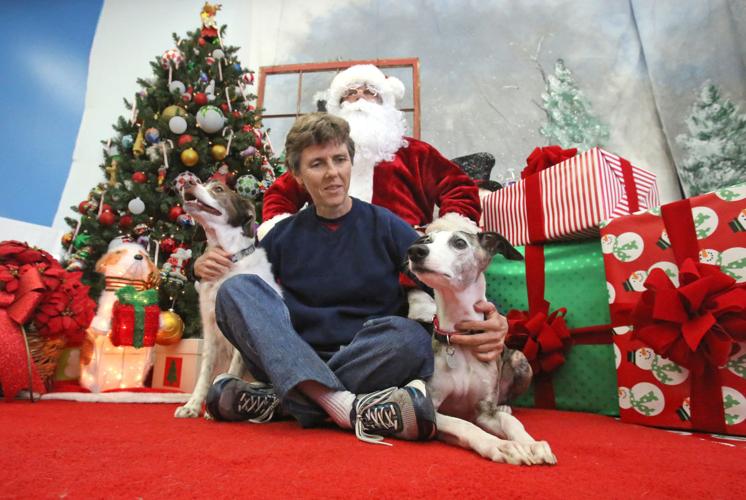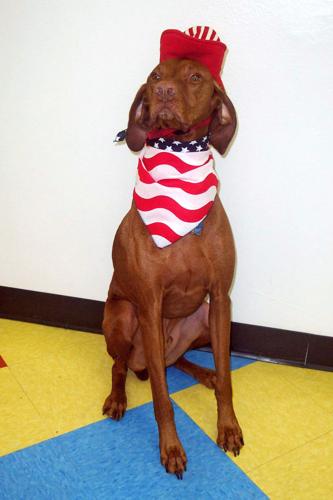University of Arizona researchers, buoyed by support from dog lovers and a California pharmaceutical startup, say a canine vaccine against valley fever could be available within 10 years.
The live vaccine, a mutant spore invented by UA fungal geneticist Marc Orbach, is called delta-CPS1. It has already protected mice from valley fever.
Researchers at the UA’s Valley Fever Center for Excellence in Tucson are optimistic, yet not certain, it will work in both humans and dogs.
But dogs are likely to get a vaccine against valley fever before humans.
There is no prevention or cure for valley fever, also known as coccidioidomycosis. An estimated 30,000 people and 60,000 dogs in Arizona get sick from valley fever every year. The disease is found mainly in dusty areas of Arizona and California. State health officials say it caused the deaths of 50 people in Arizona last year.
“We think the dog is the path to the human (vaccine),” said Dr. Lisa Shubitz, a veterinarian and associate research professor in the UA’s School of Animal and Comparative Biomedical Sciences, and part of the team working on a vaccine.
For one thing, there’s been more widespread community support in Arizona for a dog vaccine than for a human vaccine.
Over 20 years a total of $400,000 earmarked for the UA’s canine vaccine has been donated, all of it from dog lovers who have seen the toll the disease can take.
The UA’s Valley Fever Center for Excellence receives $350,000 in non-earmarked donations every year. Most of it comes from one donor: the Manhattan-based J.T. Tai & Co. Foundation, which donates $300,000 annually.
The canine vaccine funds are smaller but show broader backing. The donations frequently come in amounts of $20 or $30, from concerned and grieving pet owners who give what they can afford. Larger donations have come in from kennel clubs and owners of dog-related businesses.
“These add up and I am endlessly grateful for the support, big and small, of those who have given to this project over years, giving to a hope that we could accomplish this,” Shubitz said.
Regulatory process more condensed
A canine vaccine would go through the U.S. Department of Agriculture Center for Veterinary Biologics to get to market, while a human vaccine would need to go through the U.S. Food and Drug Administration for approval.
“The regulatory process is very similar to humans, but it is a lot more condensed for animals,” said Kwansun Ahn, CEO of Anivive Lifesciences, a veterinary pharmaceutical startup based in Irvine, California.
The UA has made some progress in moving delta-CPS1 past the development stage by partnering with Anivive. Anivive also recently acquired the license to a canine cancer drug developed at the UA.
“We are not like Big Pharma. We are not solely focused on a big opportunity of millions of dollars. For us, it’s about solving both the big and small problems,” Anivive co-founder Dylan Balsz said. “The work will not only advance it to canines but is a driving force to get it to humans. As a veterinary company it’s good to be able to play that role.”
At least two previous serious attempts at creating a valley fever vaccine failed. The first resulted in sore arms but no conclusive proof it worked. The second was a laboratory-created hybrid protein vaccine made in a yeast strain using DNA from the valley fever fungus. It looked promising but stalled because of its cost.
Politics and funding are problems for getting any valley fever vaccine to market because it is a regional, not national, disease. In humans it affects fewer than 200,000 people per year, which gives it “orphan” status. That also means it’s harder to get drug companies interested.
But since delta-CPS1 is a spore, there’s no expensive protein purification step as there was with other vaccine attempts.
“I think it has a lot of promise and potential,” said Dr. George R. Thompson, a valley fever expert who is an associate professor of medicine in the division of infectious diseases at the University of California at Davis.
Thompson, who has been researching valley fever for about a decade, said there are numerous challenges to getting a vaccine against the disease. Among other things, there’s no global market for it.
The researchers will have to show the efficacy in clinical trials and there could be genetic factors that make some dogs respond better than others to a vaccine, he said.
The same is true for humans. A 2016 CDC study found increased mortality from valley fever in non-white racial groups, The study found African-Americans had the highest coccidioidomycosis-associated mortality rate. Those genetic variances are not yet fully understood.
But eventually there will be a vaccine against valley fever, Thompson predicted, and right now delta-CPS1 is the one to watch.
“We’ll undoubtedly learn a lot from this process and I hope it works,” he said.
The delta-CPS1 researchers are hopeful about getting approved for grant applications they’ve submitted to further the vaccine development — $6 million over five years from the National Institutes of Health and $250,000 from the Arizona Biomedical Research Commission.
The UA team was heartened to see the request for proposals on the NIH grant specifically encouraged vaccines with small-market potential, and its wording cited as examples valley fever, Lyme disease and Zika virus.
The UA and Anivive are not shoo-ins for the NIH award. Dr. John Galgiani, director of the UA Valley Fever Center for Excellence, places their chances at about 20 percent.
If they don’t get the money it doesn’t mean the canine vaccine won’t move forward, but it will be a hurdle to overcome, Galgiani said.
The UA research team has in the past estimated it will be less than $40 million to get a delta-CPS1 vaccine to market. But Galgiani said it’s almost impossible to know an exact price at this stage. He said it’s like estimating how much it will cost to build a fighter plane without having a list of parts or suppliers.
“I don’t think it will be $40 million to get into dogs. It might be in the order of $20 million, maybe as low as $10 million,” he said.
Trials to include Dogs from Pima county
Anivive officials say they are aiming to get the canine vaccine to market in three to five years, though Shubitz has a more conservative view.
“If we get that grant, I think six to seven years from right now is more realistic as it will take some time to do studies,” she said.
The vaccine has not been put into dogs yet. The research team, which includes Orbach, Shubitz and Galgiani, was advised to get more regulatory input from the U.S. Food and Drug Administration before starting introductory safety and immunology studies in dogs.
Still, a timeline of three to five years is possible, USDA spokeswoman Donna L. Karlsons said. “It depends on how fast the firm develops the required data and gets manufacturing methods and facilities in place,” she said. The UA team will need to prove to the USDA that the vaccine is safe and effective.
Shubitz anticipates clinical trials for the vaccine will mostly include Arizona dogs in Pima, Pinal and Maricopa counties, along with some California dogs.
Vaccine fundraising
A recent Howliday Party at the Sit Stay Play dog day-care center in central Tucson was a fundraiser, held annually for more than a decade, for the UA Foundation’s Valley Fever Companion Animal Care Fund, money earmarked to directly fund research into the vaccine.
“Many of my client dogs have valley fever. The emotional and economic costs are enormous,” said Janet Galante, the owner of Sit Stay Play.
She holds the event, which brings in $2,000 to $4,000 each year, in memory of a former client, Tyler Ford, a vizsla who died of valley fever in 2005.
“What they are doing over there is remarkable,” Galante said of the UA researchers.
Some dogs with valley fever are euthanized because their owners cannot afford to treat them. The anti-fungal medication that is often necessary to keep the valley fever at bay for the rest of their pet’s life costs $4 to $6 per day, and blood tests and associated veterinary costs can run into the thousands. Also, blood tests can give false negatives and require additional testing and money.
Dogs will often lose large amounts of weight and the disease causes lameness and pain, or paralysis if the infection moves into the bones of the back. “Things people complain about the most to me are lack of appetite, lack of energy, and pain. They hate that the most. And severe coughing,” Shubitz said. “They really hate seeing their dogs feeling sick.”
The risk factor for acquiring valley fever is the same for dogs as for humans — breathing — and in parts of California and Arizona, impossible to avoid. It takes inhaling just one spore to become infected, though like humans, most dogs who acquire valley fever will not get sick from it. For the ones that do, the disease can result in amputations and worse.
Randy Ford had never heard of valley fever when he moved to Tucson from Salinas, California, with his dog Tyler in 2001. In the fall of 2005, Tyler became ill. “A few days before Tyler died he was raising hell — chasing toys in the pool. Then all of a sudden he quit eating, and he’d stand outside his doggie door and shake like it was cold,” Ford said. Tyler’s valley fever had disseminated into his bloodstream and his kidneys started to shut down.
Ford spent more than $5,000 trying to save his beloved dog, but Tyler was too sick. He died shortly after Thanksgiving.
“A vaccine sure would save a lot of heartache,” said Ford, an aircraft mechanic who attends the holiday party at Galante’s business every year. “Tyler was beautiful. The fungus is bad stuff.”
Six percent get ill
A 2005 UA study published in the Journal of the American Veterinary Medical Association found that dogs in Pima and Maricopa counties had a 28 percent chance of becoming infected with valley fever in the first two years of life. During that time, the chance of a dog becoming ill was 6 percent.
The risk of infection was nearly five times greater for dogs that spent more than 80 percent of their time outdoors compared with predominantly indoor dogs. Dogs with more than an acre of land to roam were found to have a risk of infection 6.2 times greater than dogs with a smaller roaming area.
No relationship was found between infection and breed, age of home, yard cover, digging behavior or proximity to construction.
“I remain confident that delta-CPS1 will effectively prevent valley fever in dogs. Whether it becomes a routine vaccine in Arizona may depend on consumer acceptance of the product,” Shubitz said.
Company officials who are raising money from investors would not divulge a price point for the vaccine, but the intent is to create a vaccine that is affordable, said Dr. Dave Bruyette, chief veterinary officer at Anivive.
Shubitz — who herself has three dogs suffering from valley fever — said that even if the vaccine costs $100 per animal, that’s a bargain compared to what many people spend on treating the disease in their dogs. It’s still unclear how often the vaccine would be needed.
“I’d vaccinate instantly if it was available,” said Sherry Botos, a Raytheon employee who attended Galante’s holiday party this year with her 2-year-old Yorkie, named Barney Fife, diagnosed with valley fever in September.
“We need to seize this moment in time,” said Shubitz, who, like Galgiani, has spent more than two decades devoted to valley fever research. “No one is going to pay for this (research effort) twice. We need to be right.”









